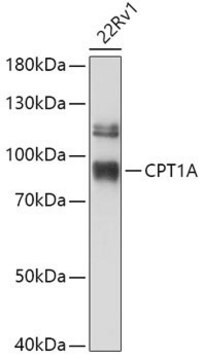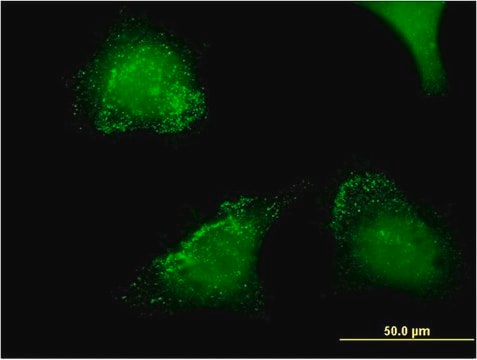MABF96
Anti-TRAcP Antibody, clone 9C5
clone 9C5, from mouse
Synonym(e):
Tartrate-resistant acid phosphatase type 5, TR-AP, Tartrate-resistant acid ATPase, TrATPase, Type 5 acid phosphatase
About This Item
Empfohlene Produkte
Biologische Quelle
mouse
Qualitätsniveau
Antikörperform
purified antibody
Antikörper-Produkttyp
primary antibodies
Klon
9C5, monoclonal
Speziesreaktivität
human
Methode(n)
ELISA: suitable
dot blot: suitable
immunocytochemistry: suitable
immunohistochemistry: suitable
immunoprecipitation (IP): suitable
western blot: suitable
Isotyp
IgG2bκ
NCBI-Hinterlegungsnummer
UniProt-Hinterlegungsnummer
Versandbedingung
wet ice
Posttranslationale Modifikation Target
unmodified
Angaben zum Gen
human ... ACP5(54)
Allgemeine Beschreibung
Immunogen
Anwendung
Entzündung & Immunologie
Entzündungs- & Autoimmunmechanismen
Immunoprecipitation Analysis: A representative lot was used by an independent laboratory in IP. (Janckila, A.J., et al. (1995). Blood. 85:2839-2844.)
Dot Blot Analysis: A representative lot was used by an independent laboratory in DB. (Janckila, A.J., et al. (1995). Blood. 85:2839-2844.)
ELISA Analysis: A representative lot was used by an independent laboratory in ELISA. (Janckila, A.J., et al. (1995). Blood. 85:2839-2844.)
Immunocytochemistry Analysis: A representative lot was used by an independent laboratory in IC. (Janckila, A.J., et al. (1996). The Journal of Histochemistry and Cytochemistry. 44(3):233-244.)
Qualität
Immunohistochemistry Analysis: 1:500 dilution of this antibody detected TRAcP in large malignant B-cells in hairy cell leukemia tissue.
Zielbeschreibung
Physikalische Form
Lagerung und Haltbarkeit
Hinweis zur Analyse
Large malignant B-cells in hairy cell leukemia tissue
Sonstige Hinweise
Haftungsausschluss
Not finding the right product?
Try our Produkt-Auswahlhilfe.
Lagerklassenschlüssel
12 - Non Combustible Liquids
WGK
WGK 1
Flammpunkt (°F)
Not applicable
Flammpunkt (°C)
Not applicable
Analysenzertifikate (COA)
Suchen Sie nach Analysenzertifikate (COA), indem Sie die Lot-/Chargennummer des Produkts eingeben. Lot- und Chargennummern sind auf dem Produktetikett hinter den Wörtern ‘Lot’ oder ‘Batch’ (Lot oder Charge) zu finden.
Besitzen Sie dieses Produkt bereits?
In der Dokumentenbibliothek finden Sie die Dokumentation zu den Produkten, die Sie kürzlich erworben haben.
Unser Team von Wissenschaftlern verfügt über Erfahrung in allen Forschungsbereichen einschließlich Life Science, Materialwissenschaften, chemischer Synthese, Chromatographie, Analytik und vielen mehr..
Setzen Sie sich mit dem technischen Dienst in Verbindung.








